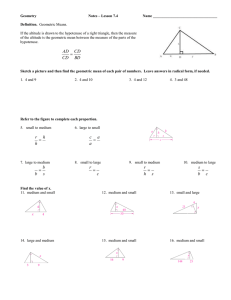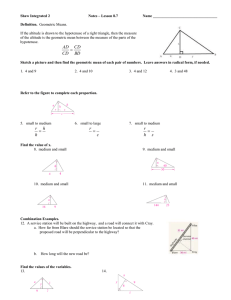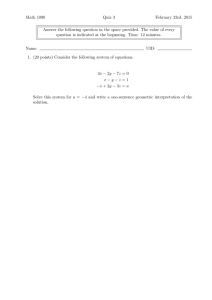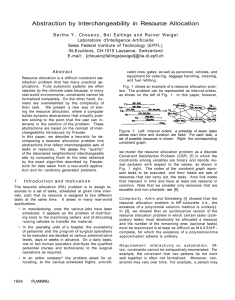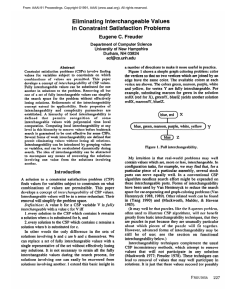Models for Geometric Composability of Engineered Physical Systems Vijay Srinivasan
advertisement
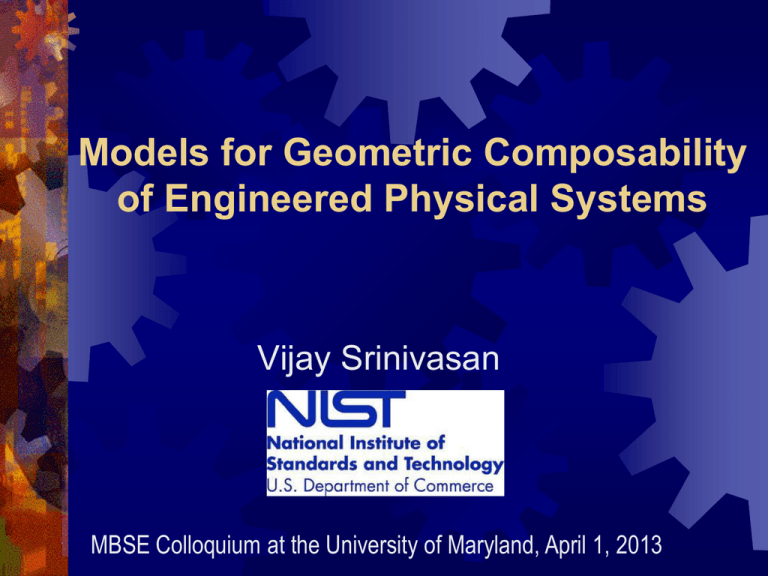
Models for Geometric Composability of Engineered Physical Systems Vijay Srinivasan MBSE Colloquium at the University of Maryland, April 1, 2013 Thesis of this Colloquium Geometric composability is enabled by geometric interchangeability in engineered physical systems. In fact, they are synonymous in this context. Engineered physical systems are fundamentally different from software systems. You cannot manufacture identical copies of physical components. Two physical components are interchangeable if they have the same ‘form, fit, and function.’ Geometry and materials are the two major deciding factors. 2 Dimensioning and Tolerancing an Industrial Part in an Engineering Drawing 3 Dimensioning and Tolerancing an Industrial Part in a 3D Geometric Model 4 Plato’s Theory of Forms 5 In Plato’s Seventh Letter (1/3) Ἔστιν τῶν ὄντων ἑκάστῳ, δι᾽ ὧν τὴν ἐπιστήμην ἀνάγκη παραγίγνεσθαι, τρία, τέταρτον δ᾽ αὐτή--πέμπτον δ᾽ αὐτὸ τιθέναι δεῖ ὃ δὴ γνωστόν τε καὶ ἀληθῶς ἐστιν ὄν--ἓν μὲν ὄνομα, δεύτερον δὲ λόγος, τὸ δὲ τρίτον εἴδωλον, τέταρτον δὲ ἐπιστήμη. For everything that exists there are three instruments by which the knowledge of it is necessarily imparted; fourth, there is the knowledge itself, and, as fifth, we must count the thing itself which is known and truly exists. The first is the name, the, second the definition, the third the image, and the fourth the knowledge. Περὶ ἓν οὖν λαβὲ βουλόμενος μαθεῖν τὸ νῦν λεγόμενον, καὶ πάντων οὕτω πέρι νόησον. If you wish to learn what I mean, take these in the case of one instance, and so understand them in the case of all. 6 In Plato’s Seventh Letter (2/3) Κύκλος ἐστίν τι λεγόμενον, ᾧ τοῦτ᾽ αὐτό ἐστιν ὄνομα ὃ νῦν ἐφθέγμεθα. A circle is a thing spoken of, and its name is that very word which we have just uttered. Λόγος δ᾽ αὐτοῦ τὸ δεύτερον, ἐξ ὀνομάτων καὶ ῥημάτων συγκείμενος· τὸ γὰρ ἐκ τῶν ἐσχάτων ἐπὶ τὸ μέσον ἴσον ἀπέχον πάντῃ, λόγος ἂν εἴη ἐκείνου ᾧπερ στρογγύλον καὶ περιφερὲς ὄνομα καὶ κύκλος. The second thing belonging to it is its definition, made up names and verbal forms. For that which has the name ‘round,’ ‘annular,’ or, ‘circle,’ might be defined as that which has the distance from its circumference to its centre everywhere equal. Τρίτον δὲ τὸ ζωγραφούμενόν τε καὶ ἐξαλειφόμενον καὶ τορνευόμενον καὶ ἀπολλύμενον· ὧν αὐτὸς ὁ κύκλος, ὃν πέρι πάντ᾽ ἐστὶν ταῦτα, οὐδὲν πάσχει, τούτων ὡς ἕτερον ὄν. Third, comes that which is drawn and rubbed out again, or turned on a lathe and broken up - none of which things can happen to the circle itself - to which the other things, mentioned have reference; for it is something of a different order from them. 7 In Plato’s Seventh Letter (3/3) Fourth, comes knowledge, Τέταρτον δὲ ἐπιστήμη καὶ νοῦς intelligence and right opinion about ἀληθής τε δόξα περὶ ταῦτ᾽ ἐστίν· ὡς δὲ these things. Under this one head ἓν τοῦτο αὖ πᾶν θετέον, οὐκ ἐν we must group everything which has φωναῖς οὐδ᾽ ἐν σωμάτων σχήμασιν its existence, not in words nor in ἀλλ᾽ ἐν ψυχαῖς ἐνόν, ᾧ δῆλον ἕτερόν bodily shapes, but in souls-from τε ὂν αὐτοῦ τοῦ κύκλου τῆς φύσεως which it is dear that it is something τῶν τε ἔμπροσθεν λεχθέντων τριῶν. different from the nature of the circle itself and from the three things mentioned before. Τούτων δὲ ἐγγύτατα μὲν συγγενείᾳ καὶ Of these things intelligence comes closest in kinship and likeness to the ὁμοιότητι τοῦ πέμπτου νοῦς fifth, and the others are farther πεπλησίακεν, τἆλλα δὲ πλέον ἀπέχει. distant. 8 Jeffersonian Assembly 9 From Paris: Thomas Jefferson’s Letter to John Jay, Aug. 30, 1785. “An improvement is made here in the construction of muskets, which it may be interesting to Congress to know, should they at any time propose to procure any. It consists in the making every part of them so exactly alike, that what belongs to any one, may be used for every other musket in the magazine…. Supposing it might be useful to the United States, I went to the workman. He presented me the parts of fifty locks taken to pieces, and arranged in compartments. I put several together myself, taking pieces at hazard as they came to hand, and they fitted in the most perfect manner. The advantages of this, when arms need repair, are evident.” 10 Interchangeable Manufacture 1765 Système Gribeauval 1801 Eli Whitney 1803 Marc Isambard Brunel 1820’s American System (Armory) Clocks, sewing machines, reapers, bicycles … Henry Ford’s automobiles … 11 American System A ‘rational’ jigs, fixtures, and gauging system; it is rational because it is based on a model. Radical departure from ‘file & fit’ craftsmanship. All fixtures are designed with reference to the model; gauges (for inspection) were made based on the model. Henry Ford: “In mass production there are no fitters.” 12 Engineering Drawings First American national standard appeared in 1935; ISO standards after WW II. Drawings (with dimensions and tolerances) defined the models. 3D geometric models with dimensions and tolerances first appeared in mid1990s. 13 Role of Congruence Theorems in Dimensioning 14 How would you dimension a triangle? …and, by the way, how would you parameterize it? Euclid’s Elements Book I Prop. 4 (side-angle-side) Euclid’s Elements Book I Prop. 26 (angle-side-angle) Euclid’s Elements Book I Prop. 8 (side-side-side) Aha! “Congruence theorems may provide the basis for a theory of dimensioning” 15 16 Two Basic Axioms … Axiom All manufacturing processes are inherently imprecise and produce parts that vary. Axiom of manufacturing imprecision: of measurement uncertainty: No measurement can be absolutely accurate, and with every measurement there is some finite uncertainty about the measured value or measured attribute. These are independent axioms and both should be considered operative in any real situation. 17 Characteristics of Interchangeability Even with the inevitable geometric variability, interchangeable parts belong to an ‘equivalence class’: 1. reflexive, i.e., A is interchangeable with A, 2. symmetric, i.e., if A is interchangeable with B, then B is interchangeable with A, and 3. transitive, i.e., if A is interchangeable with B and B is interchangeable with C, then A is interchangeable with C. 18 Dimensioning and Tolerancing an Industrial Part in a 3D Geometric Model 19 This on the drawing 0.25 ISO 1101: 2004 5.4.2.1 Means this 0.25 wide tolerance zone ASME Y14.5 - 2009 The surface must lie between two parallel planes 0.25 apart. The surface must be within the specified limits of size. FIG. 5-7 SPECIFYING FLATNESS 20 This on the drawing 0.25 r R3 SO(3) F rT 5.4.2.1 Means this 0.25 wide tolerance zone width(F) ≤ t The surface must lie between two parallel planes 0.25 apart. The surface must be within the specified limits of size. FIG. 5-7 SPECIFYING FLATNESS 21 22 Composability & Interchangeability Geometric interchangeability enables geometric composability: Modularity: Each part in the assembly is designed so that interchangeability is ensured. State-independence: Each part can be manufactured independently and then assembled. 23 Validation and Verification For geometric interchangeability: Validation of models: Tolerance analysis and synthesis. Verification of manufactured piece for conformance to specifications: Dimensional and geometric metrology 24 Interchangeability – in general Geometry is only one aspect of interchangeability of engineered physical systems. Other aspects include materials, processes (e.g., heat treatment, annealing, anodizing, carburizing) etc. Modern composite structures are a (complex) combination of geometry and materials. Variability is inherent in all these aspects of interchangeability. 25 Architecture of Physical Systems Product platforms (aka product families) are architected first. Common components, subsystems, and their interfaces are defined in these architectures using simplified geometric models. Some standards arise at the (geometric) interfaces. Other standards characterize the interior bulk properties. Physical systems are not architected as ‘stacks’. 26 Is there a Royal Road? Story: When King Ptolemy asked if there was a shorter path to learning geometry than Euclid's Elements, Euclid replied “there is no royal road to geometry.” There is no ‘royal road’ to geometric composability either – it has to be learned through years of diligent study and practice. 27 Inscription at the Entrance to Plato’s Academy in Athens Αγεωμέτρητος Μηδείς Εισίτω A moto worth adopting for Model-based Systems Engineering ! 28 Thank You! 29


